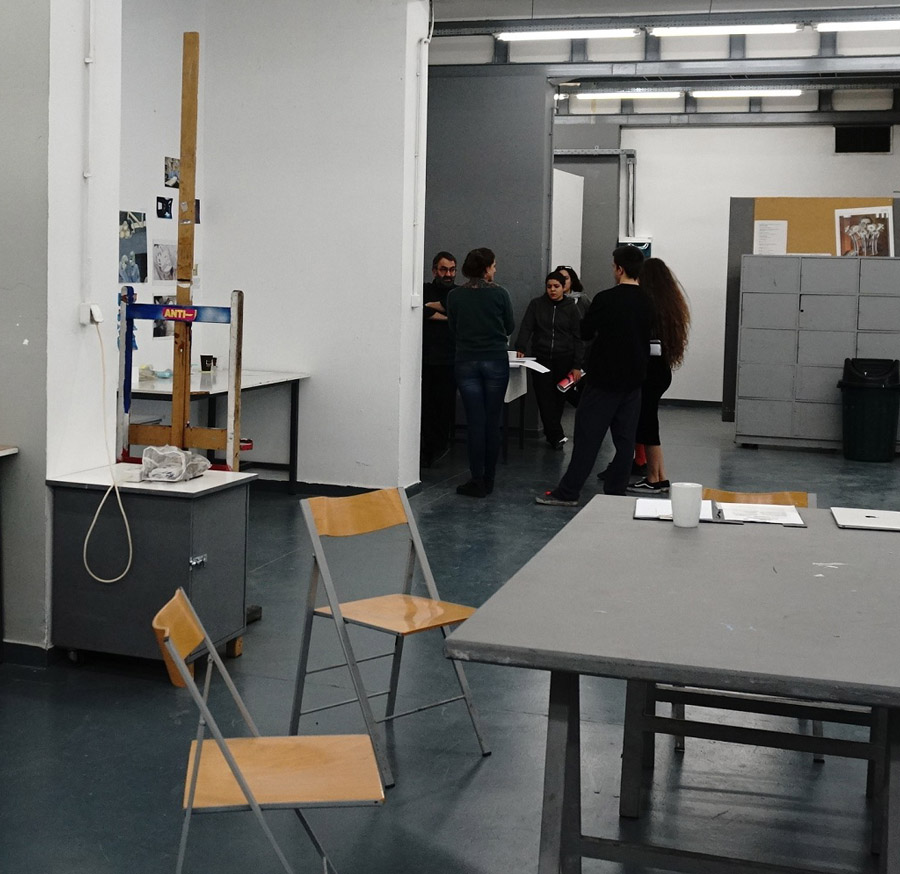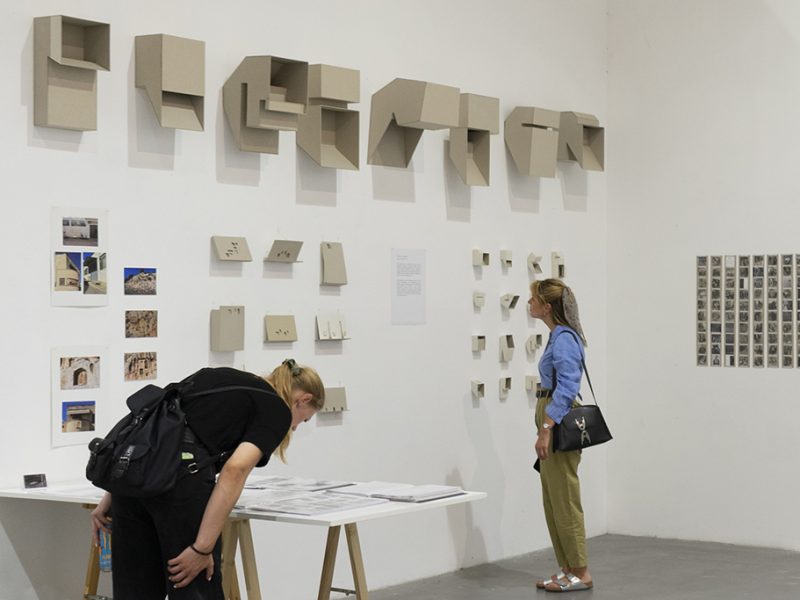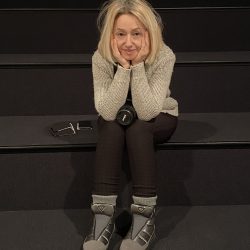9th (Θ’) PAINTING STUDIO / DIRECTOR: N. NAVRIDIS

Studio description
9th (Θ΄) Painting Studio started its operations in 2008-2009.
Structurally, the five-year study programme at the studio is divided into three cycles. The 1st cycle comprises semesters 1 to 4, the 2nd cycle semesters 5 to 9, and the 3rd cycle consists of the 10th semester, which is dedicated to the preparation of the diploma thesis. There are no specialised courses assigned to each academic year.
Within each study cycle, the thematic units (projects) are common to all students and are overseen by the professors themselves. Students from different cycles may participate in projects outside their designated cycle, provided the studio assistants approve.
The studio’s core educational pillars throughout the programme are:
-
The development of artistic skills in conjunction with the cultivation of personal artistic expression.
-
The exploration of visual art media and their historical and contemporary formations.
-
A broadened understanding of the visual arts field through collaborations and shared projects with fellow students or students from other disciplines (such as dance, theatre, poetry, cinema, and other forms of expressive practices).
-
Participation in off-campus activities such as workshops, artist residencies, and exchange visits.
-
Collaboration between the studio and groups from the wider artistic field (e.g., recent partnerships with the School of Architecture and the State School of Dance).
-
Expansion of artistic interests, visual language, and the emergence of a personal mode of expression.
At the 9th Painting Studio, students are encouraged to explore and use a broad range of artistic media without prejudice:
-
Drawing
-
The drawing process
-
Drawing as an act of transmission – projections through the act of drawing
-
Drawing-based installations and three-dimensional visual installations
-
Film, video art, moving image and its derivatives
-
Photography (analog, digital, synthetic image, applications)
-
Sound (sound works, soundscapes, sound installations)
-
Performance (use of the body)
-
Synergies and collaborations with other expressive artistic forms (joint projects and interconnections with other artistic institutions, theatre groups, architects, dance ensembles, musicians, performers, and other artistic communities)
Studio study cycles
1st cycle: 1st – 4th semester
Includes: Drawing–Painting, visual installations (60%)
Thematic units (projects) (40%)
2nd cycle: 5th – 9th semester
Includes: Thematic units proposed by the teaching staff (100%)
3rd cycle: 10th semester
Preparation of Diploma Thesis (100%)
A detailed presentation of the studio’s study cycles follows, highlighting course descriptions, the studio’s thematic units (projects), course objectives, learning outcomes, teaching and learning strategies, as well as student assessment criteria.
1st Cycle
Drawing– Painting
Emphasis is placed on drawing, particularly on the transition from representational drawing to strategies of narration, presentation, and the act of drawing as a broader process of organising and shaping expressive language.
The thematic units (projects), proposed by the professors, are accompanied by lectures and primarily by methodological approaches to the subject, including analysis, processing, and articulation of its core concepts.
Alongside research, experimentation, and the free use of materials and media in any artistic form, students become familiar with contemporary modes of artistic expression.
During the elaboration of each theme, presentations and screenings are carried out by both the teaching staff and the participating students.
The course also includes additional studio activities designed to broaden and enrich the participants’ learning and knowledge. These include visits to and invitations from Greek artists’ studios, guest lectures and seminars with international artists, discussions and collaborative workshops with artistic institutions, galleries, museums, cultural centres, art curators, and theorists.
The studio’s philosophy fosters and promotes outward-facing artistic expression. Students are encouraged to collaborate with artists from other expressive fields. The curriculum of the 9th Painting Studio anticipates and supports such joint efforts, shared projects, and creative synergies with other artistic institutions, theatre groups, dance companies, musicians, performers, and other artistic communities.
Discussions regarding the developmental stages of each project take place publicly, in the presence of the entire semester cohort, either within the studio or off-campus -particularly when it involves a joint project with another group.
Upon completion of the artworks, students are solely responsible for organising and installing their works for the final exhibition, during which their projects are evaluated.
Aims
- To explore the expressive and conceptual values of drawing and painting as media.
- To broaden both practical and theoretical knowledge.
- To develop a personal methodology and cultivate artistic skills.
- To research contemporary artistic practices through continuous study and engagement with the international art scene.
- To understand the polysemy of contemporary visual discourse and the limitless expressive means and applications it holds within modern societies.
- To engage with other artistic disciplines and appropriate their respective expressive vocabularies.
- To become confident in exhibiting artistic work and in presenting research and creative practice in public.
- To foster an understanding of the necessity for collaboration at all levels -ranging from basic interaction, participation, and facilitation in the production and exhibition process, to the formation of collective artistic groups.
Learning outcomes
Theoretical:During the development and presentation of projects, students present their research, reference materials, artistic influences, and the process of shaping their work.
Practical: Students articulate their expressive potential through a contemporary visual art discourse.
Communicative: As equal members of the group, students participate in completing the project, take responsibility for its installation (in the exhibition space), and present and defend it publicly.
Teaching and learning strategies: Lectures, group discussions, invitations to Greek and international artists, workshops, collaborations with other artistic groups, personal statements and reflexions, independent study, critical feedback and peer review.
Assessment criteria: Research, participation, creativity, breadth and quality of outcomes.
(Participation in project and quality of work: 40%, Research: 30% Presentation of the work:30%)
2nd Cycle
-
Students present their work during weekly meetings, where they articulate and defend their choices before the entire group engaged in the semester’s thematic projects, as well as students from other cycles of study.
-
These meetings include theoretical lectures, critical studies, group discussions, and presentations of artworks or artistic collectives that have significantly contributed to shaping the contemporary visual arts scene.
- Special emphasis is placed on each student’s personal thematic choices and on the process of articulating and documenting them.
Overall, students are treated as emerging professional artists who are actively claiming their space within the broader field of the creative industries – such as galleries, public art competitions and projects, advertising, publishing, television, cinema, and other artistic applications.
Aims and learning outcomes
The course aims for students to:
- Develop observation and analytical skills to better understand the phenomena shaping contemporary visual discourse and to identify its expressive boundaries.
- Comprehend the methods and practices employed by contemporary art to communicate meaning.
- Explore the broader visual and artistic landscape of the 20th century (particularly the second half), identifying artists, movements, ideas, works, or experiments that align with or resonate with their own artistic perspectives.
- Recognise how visual language enables an understanding of social reality (in which their art is situated) as well as the internal, interpersonal, and psychological dimensions it reflects and reproduces – and to position themselves accordingly.
- Identify their individual areas of interest and cultivate a personal mode of expression and critical articulation through their work.
- Confidently present and support their artistic work and concepts in public contexts.
- Expand the range of materials and media they use, and explore new fields of application.
- Experiment freely and adopt alternative methods, techniques, and expressive media in developing their artistic proposals.
Teaching strategies : Educational objectives are pursued through systematic participation in studio activities, workshops and guest visits by artists and curators, research and independent work outside the School open experimentation, engagement with contemporary art events, participation in exhibitions and collaboration.
Assessment criteria: Research and exploration, creativity and originality of proposals, participation in group discussions, presentation and defense of individual projects, involvement in artistic activities.
Semester projects (artistic output, research, thematic development): 70%. Oral presentation and defense of the project: 30%.
3rd Cycle
Student Projects – 100% Diploma Thesis.
Description
Each student selects and proposes a self-directed topic to develop for their diploma thesis. This process involves:
Research and collection of materials to support the theoretical framework and development of the chosen subject
Presentations of artworks, artists, and alternative approaches relevant to the issues addressed by the proposed topic
Free choice of media and materials (students are encouraged to propose interdisciplinary collaborations, if needed, to complete their projects)
Aims
The diploma thesis aims to:
Foster the development of a personal artistic language and critical engagement with a specific thematic area
Cultivate the multifaceted expressive potential of artistic communication
Encourage the collection of diverse information and references to support the conceptual and practical aspects of the diploma work
Serve as a preparatory step for entering the professional art world
Teaching and learning strategies
Active participation in studio activities, independent research and off-campus work, visits to and involvement in art events, participation in exhibitions outside the school
Engagement with institutions and organisations active in the contemporary art field and creative industries, including: art galleries, public competitions and commissioned projects, advertising, print media, television, theatre, dance, cinema, and other artistic and interdisciplinary applications
Assessment criteria
Originality, linguistic clarity, conceptual depth, and thematic development, artistic and technical quality of the final work.
Professional standards and consistency in the presentation and dissemination of the work.
Development, completeness, clarity, installation and presentation of the work: 60%
Documentation, written material and theoretical support: 40%

NIKOS ARVANITIS / ASSISTANT PROFESSOR
Nikos Arvanitis (b. 1979, Athens, GR) studied at the Academy of Fine Arts, Vienna, A, at the Athens School of Fine Arts, Athens, GR (Erasmus scholarship) and at the MFA course “Public Art and new artistic Strategies” at the Bauhaus University of Weimar, DE with scholarships from the DAAD (German Academic Exchange Service) and the A. S. Onassis Public Benefit Foundation. He won the first prize on the “ZeitGenosse Schiller” competition for public art, Weimar, DE, 2005, was nominated for the „5th DESTE Prize“ of the DESTE Foundation, Athens, GR, 2007, and he won the 2nd Prize of the Spyropoulos Foundation Award, Athens, GR, 2009. His artistic and research work focuses on themes, which consider the structures and possibilities of public space indwelling, the aesthetic perception in contemporary society, the construction of collective identities and the concept of the globalized, spectacular, but also institutional mass culture. Τhe medium range that his works covers is: painting, drawing, photography, video, sound installations and performances, interventions in public space, music and radio productions. Arvanitis co-founded the artist-duo Barking Dogs United with Naomi Tereza Salmon in 2005. His work has been exhibited, between others, at the 2nd Les Ateliers de Rennes – Biennial d’Art Contemporain, Rennes, (FR), 2nd Athens Biennial (GR), Halle 14 (DE), Locust Projects, Miami (USA), Townhouse Gallery of Contemporary Art, Kairo (EG), Deste Foundation Centre For Contemporary Art, Athen (GR), Institute of Contemporary Greek Art, Athen (GR), BWA Wroclaw Galeria Awangarda, Wroclaw (PL), Bâtiment d’Art Contemporain Le Commun, Geneva (CH) and at the Salon of the Museum of Contemporary Art, Belgrade (RS). Solo exhibitions at a.antonopoulou.art gallery, Athens (GR), artcore, Bari (IT), ACC Galerie, Weimar (DE)
Email: narvanitis@asfa.gr
Student Works



